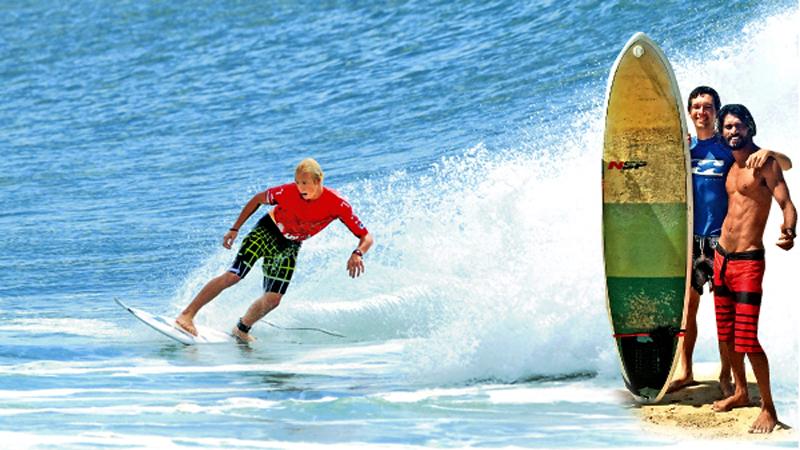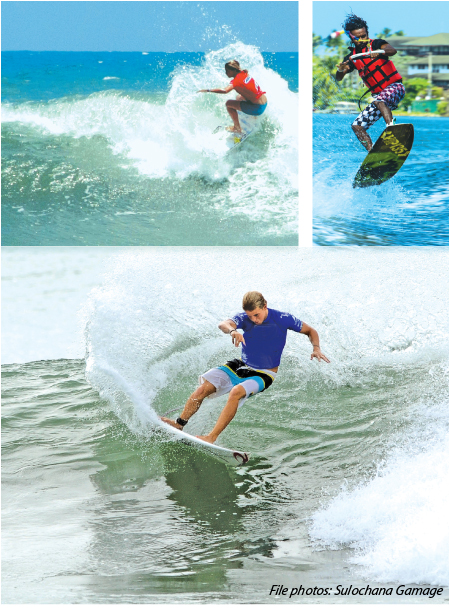
I am not a good surfer. But I think that if I spent a few months in the curving bay atWeligama, surfing every day, I could be a great one.If the island of Sri Lanka is a teardrop, Weligama sits at its very base. The town’s wide, sandy bay tames the big swells coming up from the Indian Ocean, creating a gentle, consistent surf break.
It’s a perfect place for a rookie like me to really learn to surf.
 Weligama is a 3-and-a-half hour ride away from Colombo by the 6:55 a.m. train. And then the beach is just steps away from its tiny train station.
Weligama is a 3-and-a-half hour ride away from Colombo by the 6:55 a.m. train. And then the beach is just steps away from its tiny train station.
Walking the main road down to the bay, you’ll pass vendors and hotels selling roti, rice, and curry. Busses whizz through on their way between Galle and Matara, honking their horns to clear the roads of pedestrians.
But things calm down at the beach. The bay here has supported Weligama as a fishing village for years; even today, as a giant new Marriott hotel dominates the beachfront, you’re likely to see handcrafted fishing boats crashing through the whitewater on their way back to the beach alongside the surfers.
I’ve been back to Weligama a couple of times now to surf with Batu, a young local guy who has dedicated his life to the beach.
His father is a fisherman, and so are many of his friends. He told me that he fished as his first job, but didn’t really like the work. He decided to be a surf instructor instead.
Batu now teaches at Freedom Surf School. It’s just a tent, some beach chairs, and an assortment of foam and longboards.
Day-to-day, Freedom is run by Batu’s friend, another Weligama local, but all the back-end business aspects are managed by his girlfriend, who is English. She splits her time between Sri Lanka and the UK.
Batu said this situation is far from unusual.
“If there are 20 surf schools on this beach, then there are 20 foreign women running them,” he told me, laughing.
My first experience surfing in Weligama was pretty disastrous. I rented a board from Batu on a whim, just before sunset, and cockily took off into the water. I caught a few breaking waves, and wobbily rode them into shore.
So I paddled out a bit further, to where the waves were really breaking, green walls of water curling into white foam.
I tried to catch one, and immediately got tossed: I swallowed saltwater, and cut my toe open on the board’s fin. I tried to ride a few more before the sun went down, but I’d lost my mojo.
Back on the beach, a disappointed Batu made me promise to take a lesson from him next time I was in town. He gave me a drink and sent me on my way.
So a couple weeks later, I repeated the process: I caught the morning train from Colombo, ate some rice and curry in town, and then headed down to the beach.
Batu was there waiting for me. He rubbed some more wax on a longboard, to help with grip, and then made me practice my technique down on the sand. I went through my pop-up over and over again: paddling hard, putting my hands down on the board, pushing up, and placing back foot horizontal, my front foot angled 45-degrees, and leaning forward.
When I had a good rhythm going, we set off into the water. For the first few waves, Batu pushed my board into the whitewater, like I was a child learning to swim.
But it helped. I stood strong, and rode each wave into shore easily.
So we moved to verbal commands. I paddled out to the break, and he’d yell at me.
“Paddle!”
I paddled.
“Stand up!”
I stood.
“Ride it!”
I fell.
I’d swim back out, and Batu would give me more commands.
“Your back foot was too far forward,” he said. Or, “push more weight into your front.”
After a while I started to get it. I was catching bigger waves, and standing more consistently.
Then on one wave, not huge, but big enough, something clicked. I paddled hard, and felt the wave catch and pull in my board like it had hands. The board felt stable, and I popped up smoothly.
Nature lined up for me: the suction of the wave, the small breeze, the balance, it all worked out. I rode the wave all the way to shore, the water rushing under me like a carpet.
I saw a thumbs-up from Batu out in the break.
The next day I surfed again, with less success. My body was sore, and a bit sunburned, and Batu made me sprint up and down the beach to warm up. I don’t know if he does this for everybody, or if he just wanted to see me suffer.
I caught some waves, but also fell a lot.I didn’t get that same thrilling ride from the day before, but I could feel that I was surfing differently than I had before Weligama: my pop-up was cleaner, my looks and timing were better, my stance was stronger.
Batu was satisfied enough with my progress. After a while we headed in, and then walked down the beach for some fresh fish from a stand his father sometimes sells.
We ate the fish grilled, with chips, and put back a couple Lion beers. Out in the waves, people surfed, and a fishing boat came crashing into shore.
Afterwards, I walked back to the train station, my wet swimsuit soaking my backpack and sand falling out of all of my clothes. It was an itchy ride back to Colombo.
This month, Batu is opening his own surf school in Weligama: the “Batu Surf School.” Next time I go back, he won’t be just a surf teacher, but a businessowner.
And next time I go back to Weligama, maybe I won’t be such a flounder, but a better surfer.
